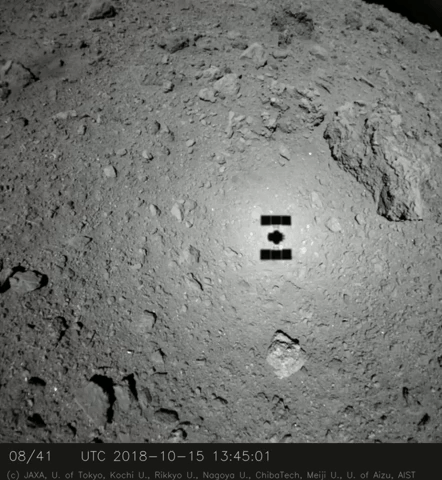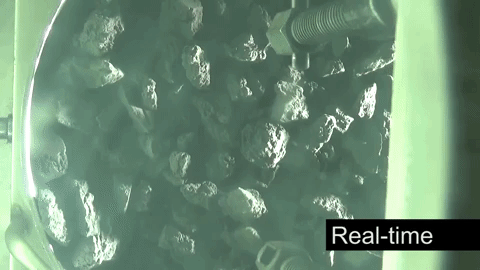Jason Davis • Feb 19, 2019
What to expect when Hayabusa2 collects a sample from Ryugu
More than 4 years after launch and a half year surveying asteroid Ryugu in space, Japan's Hayabusa2 spacecraft is ready for its biggest moment yet: sample collection. The spacecraft is scheduled to touch down on Ryugu at 08:15 Japan time on 22 February (21 February 23:15 UTC, 18:15 EST). If all goes well, Hayabusa2 will gently touch Ryugu with its meter-long sample horn, fire a bullet made of tantalum into the surface, and capture the resulting cloud of dust and debris.
JAXA plans to hold a press briefing at 15:00 Japan time on 20 February, and another just 3 hours before touchdown. It usually takes a couple of days for JAXA to translate press materials to English, so it may be difficult for non-Japanese speakers to find out more news before the big moment. The best way, then, to follow the mission is JAXA's Hayabusa2 English Twitter account, and of course, this guide!
Hayabusa2, Japan's mission to Ryugu and other asteroids
Japan's Hayabusa2 spacecraft returned a sample from asteroid Ryugu to Earth in December 2020.
What we'll see
The good news is that JAXA will offer a web broadcast with English translations, most likely on its YouTube channel, starting an hour before touchdown to an hour afterwards, so we'll be able to follow the excitement as it happens. JAXA will also post real-time images from Hayabusa2's optical navigation cameras as it descends to Ryugu, just as they did during touchdown rehearsals. During those rehearsals, a new image came in roughly every half hour. That's about as real-time as you can get when it comes to watching a spacecraft do its job from 19 light-minutes away.
The bad news is that the stream of optical navigation images will stop about 48 minutes before touchdown, when Hayabusa2 turns its high-gain antenna away from Earth to assume the proper orientation for landing. The only indication that everything is going well will be Doppler shifts in the signal coming from the spacecraft's low-gain antenna. Hayabusa2 will be on its own during this final descent, approaching the touchdown site through a series of automated checkpoints, during which the spacecraft can conduct an "abort (urgent rise)," according to press materials, if anything goes wrong. The spacecraft successfully performed one of these aborts during an earlier rehearsal.
Just a second after touchdown, Hayabusa2 begins to rise off the surface. That should produce a change in the Doppler shift of Hayabusa2’s radio signal, which will undoubtedly be a celebration moment for the JAXA team. Full relief won't come for at least another 7 minutes, when Hayabusa2 switches back to its high-gain antenna and starts transmitting health and telemetry data again. At some point after that — the exact timing is uncertain — we'll start seeing pictures from touchdown, including some from the spacecraft's small monitor camera (CAM-H), which keeps an eye on the sample horn.
Touchdown site
Hayabusa2's touchdown site is a 6-meter-wide circle named L08-E1. It's near Ryugu's equator, roughly between Kintaro crater to the west and Brabo crater to the east. Here's a JAXA diagram with the landing site as a red box:

Here's a wide shot I made using a NavCam image, with the landing site circled. Brabo crater is visible as the big indentation on the right:

And finally, here's an animation I made using prior touchdown rehearsal images that pauses to circle the landing site:

Even though it's the smaller of the two final regions the team was considering for sample collection, L08-E1 won out because the rocks there are smaller than 60 centimeters, and it's closer to the target marker Hayabusa2 dropped, meaning the spacecraft can keep it in view for longer as it descends.
The last time I asked, the team was confident they could land Hayabusa2 within a meter of where they aimed. The entire spacecraft doesn't have to fit inside that 6-meter circle — just the sample horn. There are some larger boulders just east of L08-E1, so flight controllers are bringing in the spacecraft "tail up," with the back of the spacecraft raised 5 to 10 degrees in the direction of those boulders, just to give themselves a little extra margin.

Touchdown procedure
The entire landing procedure lasts roughly 2 days, from when Hayabusa leaves and eventually returns to its 20-kilometer home position. Here's a timetable of events in Earth-received time; just subtract 19 minutes from any cell to find out when something actually happened on the spacecraft. JAXA notes that these times are not fixed and may change.
Update 21 Feb: JAXA updated some of their times in the latest press briefing. Those updated times are now shown in italics.
| Event | ERT (PST) | ERT (EST) | ERT (UTC) | ERT (Japan) |
|---|---|---|---|---|
| Gate 1: Decision on start of descent | 14:13 20 Feb | 17:13 20 Feb | 22:13 20 Feb | 07:13 21 Feb |
| Depart 20-kilometer home position at 0.4 m/s | 15:32 20 Feb | 18:32 20 Feb | 23:32 20 Feb | 08:32 21 Feb |
| Slow rate of descent to 0.1 m/s Gate 2: Begin deciding whether to continue descent | 01:52 21 Feb | 04:52 21 Feb | 09:52 21 Feb | 18:52 21 Feb |
| Gate 3: GO/NO GO on final descent | 13:02 21 Feb | 16:02 21 Feb | 21:02 21 Feb | 06:02 22 Feb |
| Switch from LIDAR to Laser Range Finder (LRF) at 45 meters above surface Switch from high-gain antenna (HGA) to low-gain antenna (LGA) | 14:27 21 Feb | 17:27 21 Feb | 22:27 21 Feb | 07:27 22 Feb |
| Gate 4: Touchdown and acceleration away from Ryugu | 15:25 21 Feb | 18:25 21 Feb | 23:25 21 Feb | 08:25 22 Feb |
| Gate 5: Switch from LGA to HGA | 15:44 21 Feb | 18:44 21 Feb | 23:44 21 Feb | 08:44 22 Feb |
| Decelerate ascent and switch to LIDAR | 19:27 21 Feb | 22:27 21 Feb | 02:27 22 Feb | 11:27 22 Feb |
| Gate 6: Start confirmation of speed change to reach home position | 01:37 22 Feb | 04:37 22 Feb | 09:37 22 Feb | 18:37 22 Feb |
| Accelerate toward home position | 02:37 22 Feb | 05:37 22 Feb | 10:37 22 Feb | 19:37 22 Feb |
(Note: JAXA has not listed an estimated time for Hayabusa2's return to home position.)
Most of those 6 gates you see in the above timeline are human-decided go/no-go points. But there are also 4 additional checkpoints where Hayabusa2’s autonomous guidance and navigation system will verify things are okay between proceeding to the next step. This is where that "abort (urgent rise)” comes into play if anything goes wrong.

The first of these checkpoints comes at 45 meters above Ryugu, after Hayabusa2 switches antennas, shutting off the flow of health telemetry back to Earth. Assuming everything looks okay, the spacecraft switches to from LIDAR to its Laser Range Finder and starts looking for the target marker. Once it finds the marker, it locks on, triggering a second checkpoint. It then drops to 8.5 meters above the target marker and moves horizontally toward the touchdown site, which is just a few meters to the east. Then, the spacecraft gets into its "tail-up" orientation, completing checkpoint 3. From there, the spacecraft moves into its final position, passing a fourth and final checkpoint, and then free-falls to touchdown. Based on an animation shown during the last press briefing, that 8.5-meter free-fall will take about 112 seconds.
Sample collection
The moment that Hayabusa2's meter-long sample horn touches the surface, it fires a bullet made of tantalum from within the horn. The 5-gram bullet hits Ryugu at about 300 meters per second, stirring dust and small particles up the horn, through a 90-degree turn, and into a sample catcher. The bullet is made from tantalum so scientists can distinguish pieces of it from the sample material.

Originally, the Hayabusa2 team expected Ryugu to be covered in regolith, meaning the bullet shouldn't have had any problem spreading a sample up into the spacecraft. But the MINERVA-II1 and MASCOT rovers showed that the surface was mostly covered with gravel. Would the sample collection procedure still work?
To find out, the team fired a flight spare bullet into a container of Ryugu-like gravel, and filmed the results. Not only did they collect material, "the resulting sample amount exceeded the initial assumption that would be released from the surface." The pre-mission plan was for Hayabusa2 to collect at least 100 milligrams of fine-grained material, and several millimeter-sized chunks. I’m not clear on whether the team is saying the new test exceeded those original assumptions, or just their pre-test predictions. Either way, the team is happy, and they're confident they'll get even more material during the actual sample collection, because Ryugu’s gravity is so much weaker than Earth’s.

The sample collection process literally takes just a second; Hayabusa2 fires its thrusters just 1 second after touchdown to avoid tipping over. The sample horn has a lip around the bottom opening to catch a few small pieces of gravel as they tumble back out. When the spacecraft decelerates later in its ascent, those pieces will have a second chance to rise up and into the sample catcher.
Ascent and what’s next
After touchdown, Hayabusa2 makes its way back to the home position. There's no way to know for sure how big a sample the spacecraft captures until the return capsule is opened back on Earth. If the tantalum bullet fires as planned, they are almost certain to have collected a good sample. In the case of the first Hayabusa mission, the bullet didn’t fire, but a few particles of asteroid Itokawa still made their way into the sample container.
Amazingly, there’s more mission excitement yet to come. The spacecraft can collect three samples in total, but the team is waiting to see how this first attempt goes before deciding whether to make a second attempt.
Beyond that, there’s another experiment to look forward to. The Small Carry-on Impactor (SCI) contains a box of explosives and a copper bullet (this mission has lots of bullets!) to create an artificial crater on the surface. The team could choose to collect a sample from that crater.
When the spacecraft finishes collecting its sample(s), a spring pushes the sample catcher into the return capsule, which sits inside the reentry capsule. Hayabusa2 will spend most of 2019 at Ryugu, waiting for the planets to align, before returning to Earth in 2020.
Let’s Go Beyond The Horizon
Every success in space exploration is the result of the community of space enthusiasts, like you, who believe it is important. You can help usher in the next great era of space exploration with your gift today.
Donate Today

 Explore Worlds
Explore Worlds Find Life
Find Life Defend Earth
Defend Earth


